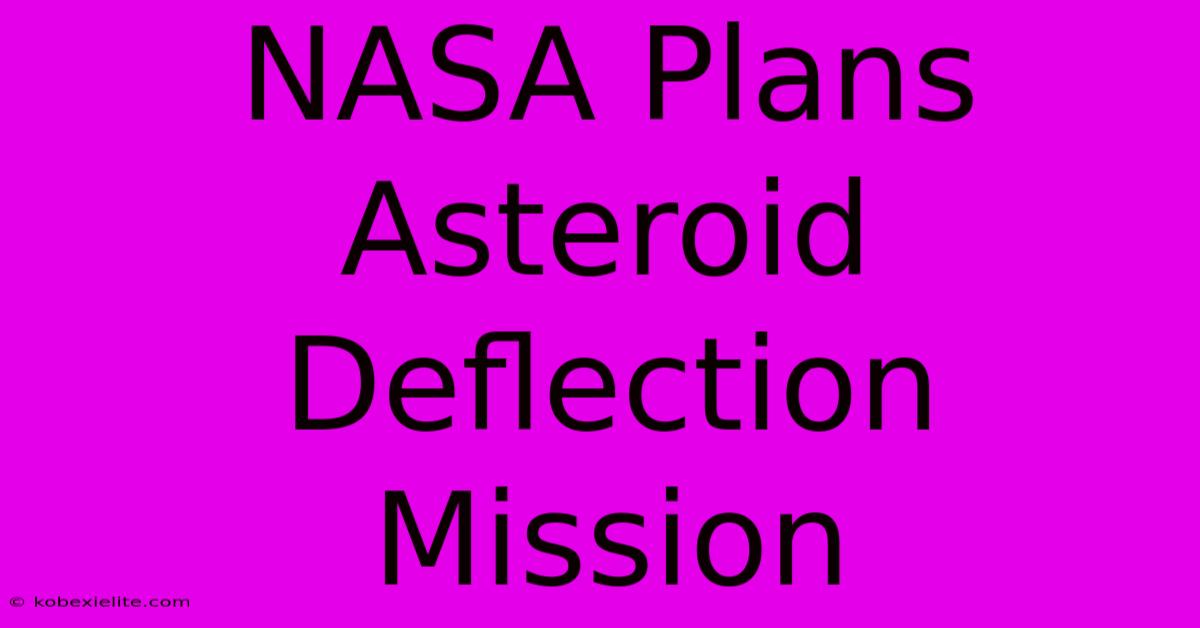NASA Plans Asteroid Deflection Mission

Discover more detailed and exciting information on our website. Click the link below to start your adventure: Visit Best Website mr.cleine.com. Don't miss out!
Table of Contents
NASA Plans Asteroid Deflection Mission: A Deep Dive into the DART Mission and Future Planetary Defense
The vast expanse of space holds both wonder and potential danger. Among the celestial bodies orbiting our sun are asteroids, some of which pose a potential threat to Earth. Recognizing this, NASA has spearheaded ambitious missions to understand and mitigate these risks. This article delves into NASA's plans for asteroid deflection, focusing on the groundbreaking Double Asteroid Redirection Test (DART) mission and outlining future strategies for planetary defense.
The DART Mission: A Test of Planetary Defense
The Double Asteroid Redirection Test (DART) mission, launched in November 2021, marked a pivotal moment in humanity's quest to protect our planet. This ambitious project aimed to test a novel technique for deflecting potentially hazardous asteroids: kinetic impact. Instead of relying on nuclear weapons or other potentially less precise methods, DART employed a controlled collision with the asteroid Dimorphos, a moonlet orbiting the larger asteroid Didymos.
How DART Worked:
The DART spacecraft, essentially a highly specialized impactor, was deliberately crashed into Dimorphos at a high speed. The impact, while not designed to completely destroy the asteroid, aimed to alter its orbital period around Didymos. By carefully measuring the change in Dimorphos's orbital trajectory, scientists could gather crucial data on the effectiveness of this kinetic impact technique.
DART's Success and its Implications:
The mission was deemed a resounding success. DART successfully altered Dimorphos's orbital period, proving the feasibility of using kinetic impactors to deflect asteroids. This success provides invaluable data that will inform future planetary defense strategies. The information gleaned from DART is crucial for refining models and developing more effective deflection techniques for larger, potentially more threatening asteroids.
Beyond DART: Future Plans for Asteroid Deflection
While DART demonstrated the effectiveness of kinetic impact, NASA and the international community are exploring a range of other methods for asteroid deflection. These include:
-
Gravity Tractor: This method involves placing a spacecraft near an asteroid to use its gravitational pull to gradually nudge the asteroid off course over a long period. This is a more gentle approach, suitable for asteroids detected many years in advance.
-
Ion Beam Shepherding: This futuristic approach utilizes focused ion beams to gently push an asteroid off course. It requires significant technological advancements, but holds immense potential for precise and controlled deflection.
-
Nuclear Option: While considered a last resort due to its potential risks, a nuclear explosion near an asteroid could significantly alter its trajectory. This option remains on the table for exceptionally large and dangerous asteroids.
The Importance of Early Detection and International Collaboration
Effective asteroid deflection relies heavily on early detection. NASA and other space agencies are actively engaged in asteroid survey programs, using powerful telescopes to identify and track potentially hazardous objects. The earlier an asteroid is detected, the more time and options available for implementing deflection strategies.
International collaboration is also critical. Asteroid deflection is a global challenge requiring the coordinated efforts of multiple nations and scientific organizations. Shared data, technology, and expertise are essential for developing a robust and effective planetary defense system.
Conclusion: Protecting Our Planet, Together
NASA's plans for asteroid deflection represent a proactive and crucial step in safeguarding our planet from potential asteroid impacts. The successful DART mission has paved the way for more advanced and refined techniques, and continued investment in early detection and international collaboration is vital to ensuring the long-term safety of Earth. The future of planetary defense rests on our continued commitment to understanding and mitigating the threats posed by near-Earth objects. The success of DART is a testament to humanity’s ingenuity and its dedication to protecting our home.

Thank you for visiting our website wich cover about NASA Plans Asteroid Deflection Mission. We hope the information provided has been useful to you. Feel free to contact us if you have any questions or need further assistance. See you next time and dont miss to bookmark.
Featured Posts
-
Icc Champions Trophy India Bangladesh Live Match
Feb 21, 2025
-
Penguins Legends One Of A Kind Honors
Feb 21, 2025
-
Keegan Wright Home Broken Into
Feb 21, 2025
-
Todays Market Walmart Pullback
Feb 21, 2025
-
Chef At Rick Steins Found Dead
Feb 21, 2025
